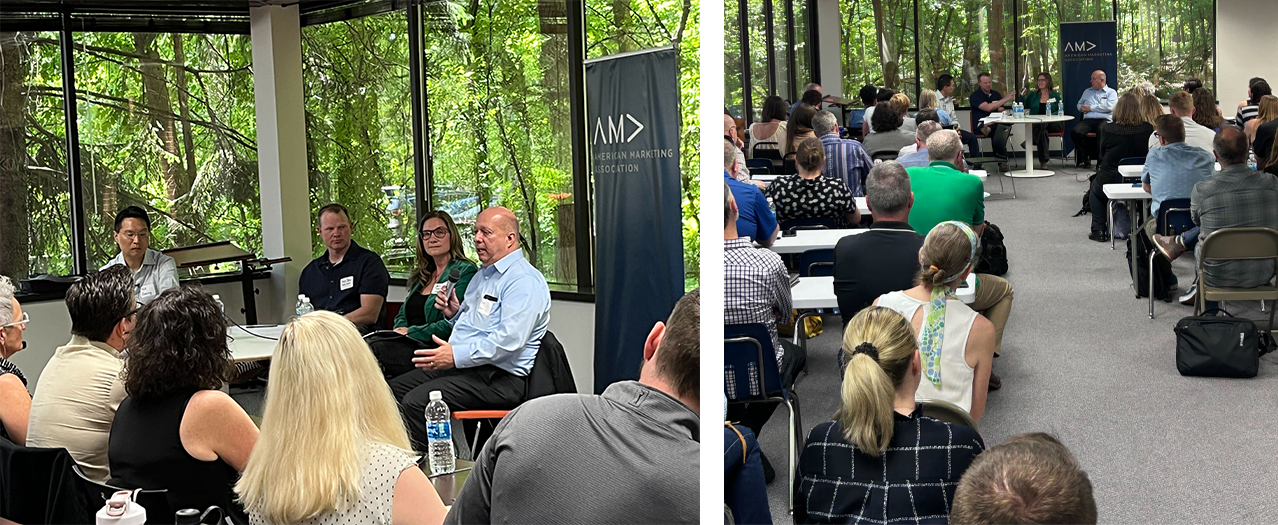 Are you out there treading water in the vast ocean of new AI tools and capabilities? Possibly even drowning in it?
Are you out there treading water in the vast ocean of new AI tools and capabilities? Possibly even drowning in it?
Well you’re not alone!
It seems like AI is making headlines daily, and evolving before you can even comprehend what you have in front of you.
So what’s a responsible marketer got to do to keep up and not become obsolete?
ANA Business Marketing, AMA Milwaukee and Stream Creative recently held an interactive panel event to have an open discussion about the future of marketing and AI from a leadership, IT, and in-house marketing perspective.
Below are the highlights of the panel discussion covering getting started, challenges, responsible uses, and general questions regarding AI in marketing.
Featured Panelists
- Milt Hwang, Principal at Mission MarTech LLC served as Moderator and works as a Strategic Marketing Consultant with a focus on marketing technology
- Steve James, Co-founder and Agency Partner at Stream Creative representing a leadership persona
- Jen Adamski, Director of Marketing at Magellan Promotions representing a in-house marketing persona
- Mike Cleary, CIO at Sentry Equipment representing an IT persona

Basic Terms to Know When Discussing AI
One of the main goals of this panel was to give attendees a baseline of knowledge about AI to help them better understand the technology. So before we dive into the highlights, here are a few basic terms to know when getting started with AI.
- Artificial Intelligence (AI): The field of computer science focused on creating machines and systems that can perform tasks that typically require human intelligence.
- Machine Learning (ML): A subset of AI that involves developing algorithms and models that allow machines to learn and make predictions or decisions based on data without being explicitly programmed.
- Deep Learning: A specific approach within machine learning that uses deep neural networks with multiple layers.
- Training Data: The labeled or unlabeled dataset used to train an AI model. It serves as input for the learning algorithms and helps the model recognize patterns and make predictions.
- Dataset: structured collection of data that is organized and stored for analysis or processing.
- Bias in AI: Refers to the presence of prejudice or unfairness in AI systems, often resulting from biased training data or biased algorithmic decision-making.
- Algorithm: A set of well-defined instructions or procedures used by an AI system to solve a specific problem or perform a particular task.
- Model: The output of an algorithm.
- Use Case: a specific application or scenario where artificial intelligence technologies are employed to solve a particular problem or provide value.
- Generative AI: A branch of artificial intelligence that focuses on creating or generating new content, such as images, music, text, or other forms of creative output.
What Use Cases Can We Use AI for in Marketing?
A simple question with a pretty big answer! Consider this quote from Marketing Artificial Intelligence: AI, Marketing, and the Future of Business:
“The three broad categories of AI are language, vision, and prediction. Within those categories are dozens of AI applications that can be used to make your marketing smarter. And within those dozens of AI applications are thousands of use cases that can drive efficiency and performance in your business.”
You read that right, there are thousands of use cases for marketing. So the good news is you have options, the bad news is you may have too many options.
To narrow your options down, consider your biggest roadblocks, and search tools for those.
According to Our Panelists, AI Can Be Effectively Used to Solve the Following Marketing Challenges:
Small Budget: A problem most marketers are all too familiar with! Small budgets can mean smaller teams, a limited number of retainer hours, and resources. And yet, the boss expects Gucci results on a Goodwill budget. AI can be used to create efficiencies freeing you up to focus on strategy and stretching your dollar a little further.
Few Resources: Most likely a result of the “small budget” challenge above. When used effectively (and creatively) the right AI tool can be used to fill the gaps left by the tools you don’t have.
Generating Code: A bit more on the IT side of things, AI can be used to generate code. Common techniques include:
- Template-based code generation
- Natural language processing
- Reinforcement learning
- Genetic algorithms
- Neural program synthesis
It should be noted that AI helps with optimization and saving time, human programers are still extremely necessary for quality control.
Brainstorming: Got a lot of content to create but wish you had someone to bounce ideas off of? Try AI! It can be a great starting point for idea generation, basic concepts and expanding on concepts you’ve already created.
Want to get the most out of content creation using AI, while still retaining the necessary human components? Check out our blog, Content and AI: How to Leverage AI (Responsibly) to Boost Content Strategy and Content Development.
Research: Various AI tools can be used for data analysis, finding trends, and even providing a glance into your competitors data! A particular tool that was brought up was ChatSpot, an AI that combines the power of ChatGPT and the HubSpot CRM. This tool can help with:
- Sales prospecting
- Generating images
- Content drafting
- Finding insights from company data found in the CRM
- Analyzing SEO
Check it out if you haven’t already!
Busy Work: There are only so many hours in a work day. You should be focusing on creative strategy and the kind of work you enjoy doing. Leave the busy work like data entry, basic search and categorizing data to the machines!
Looking for more ideas? Follow this link to learn how to use AI to enhance your content team’s effectiveness.
How Do I Decide Which AI Tools Are Best for Me?
There are so many AI tools out there, how do you decide what’s best for you?
Start by looking into the tools you’re already using daily or are already integrated into your systems. Odds are they have AI integrations already, see what’s compatible without having to do an overhaul of your existing process.
You should also look at your process and decide where you could best create efficiencies. Research? Brainstorming? Content outlines? Once you have your answer, that will narrow down your search.
What Would You Say to Process Driven Companies Who Are Hesitant to Start With AI Because It’s “Messy” and a Lot of Factors Are Unknown?
If your company is very process-driven, then AI is a perfect solution (if used correctly). All AI tools are very structured; starting with it will be the most time-consuming part, but once it's implemented it should only improve your process.
Even if your company isn't using AI, your competitors are. Refusing to adapt to new technologies will force your company several steps back. You may have to be the one to step up and start creating a new process involving AI. Play with it, understand it, and discover how it makes sense in your organization.
AI technology constantly changes, as does how the world responds to it. Your team needs to remember this and know that you will need to pivot as needed.
Review our list of AI-powered tools that you may want to consider adding to your A-team.
AI Is Grabbing Answers From Webpages Without Visiting Those Pages and Homogenizing All the Content It Finds. How Will This Affect Website Traffic, and Where Does Branding Play Into All This?
Have you ever tried to read an article or paper behind a paywall, then decided to ask ChatGPT about it and find that you’re getting the information you wanted anyway? Convenient! Unless you’re the person who benefits from the paywall that is…
Basic human nature is laziness. We love the aspect of googling where you type in a simple question, but then you have to sort through all the answers it gives you? UGH. You have to be the synthesizer when it comes to sorting through Google results. But now, AI is the synthesizer. And it’s giving answers that are easy to read. It’s also pulling those answers from many sources, possibly even your website!
For many marketers, website traffic and bottom of the funnel actions are THE goal to achieve. The fact of the matter is that AI search means losing clicks, and that’s something we all need to keep in mind when it comes time to do our reporting.
One solution is to think of new channels to start utilizing more, such as newsletters or LinkedIn, that allow you to directly talk to your audience. Evaluate where your traffic is coming from and strategize accordingly.
For those who are coming to your website, make sure your branding is strong and that they have a personalized and very helpful experience.
Speaking of branding, your brand voice is so very very important! AI content is, to put it kindly, vanilla. Setting yourself apart and bringing in personality has never been more vital. You want to have a point of view and deep insights.
So how is your brand doing that? Consider video, graphs, charts, sales assistance with a real person, or anything else that displays your business’ unique strengths.
Do Companies Need to Disclose if They Are Using AI? Who in the Organization Is Responsible for Creating an AI Use Policy?
The need for companies to disclose their use of AI depends on the specific context. After all, autocorrect is an example of AI technology, and no one cares if you're using that or not.
However, consider data protection and privacy. If you have AI systems processing personal data, companies may need to comply with data protection regulations like GDPR.
HOT TIP: Don't put any confidential information in ChatGPT! It will become part of the index.
Generally, transparency is important to people. Consider how your company thinks of AI and how you plan on using it. Work with your directors and executive team to get these answers and consider adding something to your privacy policy or terms of service.
These policies will change as the tools do. Be prepared to adapt.
For more information, read the article Why Every Company Needs Responsible AI Policies—Now or review an example of an AI policy here.
How Do You Keep Up With AI Tools?
There are two main answers to this question.
Answer one: You can keep up with AI tools, from a usability standpoint, by having a strong foundational knowledge of how AI works and knowing how to prompt.
Learning how AI works will help you to adapt to different tools faster. Learning how to prompt (otherwise known as prompt engineering) will help you search and interact. A basic understanding of prompting will help you on many platforms and get you a better response.
Essentially, a good prompt is just a good question. Homogenization happens in the first response AI gives you. You need to suggest another point of view to get better answers.
HOT TIP: Revisit the art of the creative brief to create better prompts. Who is the audience I am trying to reach? What am I trying to achieve? This will get you asking the right questions.
Answer one: You can keep up with AI tools, in terms of knowing about new technology, by engaging with your professional network.
The human touch! Truly there is no replacement for human connection.
- Ask your coworkers
- Get involved with the discussion on LinkedIn
- Become a member of your local HubSpot User Group, ANA Business Marketing, or AMA Milwaukee
Learn about what’s working and what’s not from those you trust and have similar goals to yourself. There are also several resources online to help keep you in the loop. A specific newsletter suggested at our panel was Ethan Mollick’s One Useful Thing along with the Milky Way Tech Hub.
More Helpful AI Resources:
- The Marketing AI Show - Podcast
- Marketing Against the Grain - YouTube Channel
- 5 Work Ethic Traits ChatGPT or Any AI Tool Can’t Give You - Blog
- Content and AI: How to Leverage AI (Responsibly) to Boost Content Strategy and Content Development - Blog
- Salesforce Einstein vs Microsoft Copilot vs HubSpot ChatSpot vs Adobe Sensei - Smart CRM AI Comparison 2023 - Blog
Got an idea for another event or want to pick our team’s brain on strategy and implementation? Reach out to us! We love making new friends and talking tech!






